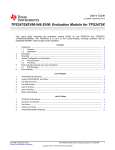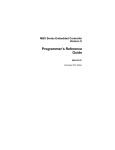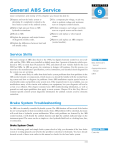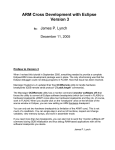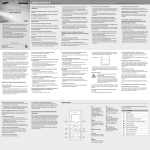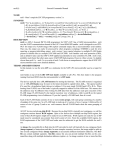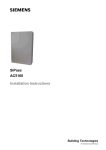Download Optimizing Code Performance and Size for
Transcript
Optimizing Code Performance and Size for
Stellaris® Microcontrollers
Application Note
AN01 265 -0 2
Co pyrigh t © 2 007– 200 9 Te xas In strumen ts
Application Note
Optimizing Code Performance and Size for Stellaris® Microcontrollers
Copyright
Copyright © 2007–2009 Texas Instruments, Inc. All rights reserved. Stellaris and StellarisWare are registered trademarks of Texas Instruments.
ARM and Thumb are registered trademarks, and Cortex is a trademark of ARM Limited. Other names and brands may be claimed as the property
of others.
Texas Instruments
108 Wild Basin, Suite 350
Austin, TX 78746
Main: +1-512-279-8800
Fax: +1-512-279-8879
http://www.luminarymicro.com
June 24, 2009
2
Application Note
Optimizing Code Performance and Size for Stellaris® Microcontrollers
Table of Contents
Introduction ......................................................................................................................................................... 4
Detailed Information on Performance and Size Factors ..................................................................................... 7
Compiler Switches .......................................................................................................................................... 7
Use of Interrupts ............................................................................................................................................. 8
Critical Sections ........................................................................................................................................ 10
Spin Locks ................................................................................................................................................ 10
Size of Variables ........................................................................................................................................... 11
Use of Global Variables ................................................................................................................................ 12
Aliasing and Global Reload....................................................................................................................... 12
Use of Locals to Avoid Excess Loads and Stores .................................................................................... 13
Const Types.................................................................................................................................................. 13
Taking Address of Local Variables ............................................................................................................... 13
Accessing Peripherals (at Fixed Address) .................................................................................................... 14
Use of C Standard Library ............................................................................................................................ 16
Asm() Inserts................................................................................................................................................. 16
Asm with Keil/ARM ................................................................................................................................... 16
Asm with GCC .......................................................................................................................................... 17
Floating Point ................................................................................................................................................ 18
Volatiles ........................................................................................................................................................ 18
Back-to-Back Writes to Peripherals .............................................................................................................. 18
Immediate Use of Loads from Peripherals.................................................................................................... 19
Recursion...................................................................................................................................................... 19
Many Small Functions................................................................................................................................... 19
Too Many Function Parameters.................................................................................................................... 20
Conclusion ........................................................................................................................................................ 20
References ....................................................................................................................................................... 20
June 24, 2009
3
Application Note
Optimizing Code Performance and Size for Stellaris® Microcontrollers
Introduction
This application note provides a summary of main factors that affect code performance and size for
Stellaris® microcontrollers as well as a detailed discussion of how to improve code performance and
size including example code where useful. Table 1 provides a summary of the main factors.
Table 1.
Main Factors Affecting Performance and Size
Factor
Impact
Hidden Cost
Compiler
switches (see
page 7)
• Code
performance
• Code size
Code and/or data are larger or slower than
expected due to not getting the most from the
compiler.
Interrupt usage
(see page 8)
• System load
This includes overhead, worst-case nesting, and
• Responsiveness latency (especially if there are not enough
priorities). Multi-cycle instructions will hold off
interrupt. Higher priority interrupt coming in
during servicing is held off.
“Stubs” and hidden code to handle interrupts in
software.
Variable size
(see page 11)
•
•
•
•
Algorithm time
Load/store
Computation
Extra code
size (often
dramatic)
Using variables larger than the processor is
comfortable with means extra loads/stores, extra
computation (software routines versus
hardware), or far slower instructions. This often
ends up as calls, which does not add to size, but
does significantly affect performance.
Stellaris and ARM®
Cortex™-M3
Each compiler has its own
switches (see page 7). But,
minimally, use of –O2 or –O3
along with optimizing for time or
space is crucial.
Stellaris parts have very fast
interrupt response, will interrupt a
multi-cycle instruction
(interrupt-continue for LDM and
STM, unlike the blocking ARM7/
ARM9 for example), and support
8 levels of fully nested priority.
Long long is generally optimized
due to special instructions (for
example, ADDC and UMULL).
Using variables smaller than optimal may mean
extra instructions to sign or unsign extend (on
load and after computations). These may also
prevent the use of optimal load and store
instructions.
Smaller globals and statics are
okay, but locals are best as ints
and unsigned ints (or longs). If
globals/static are used a lot, copy
to int locals for duration, and copy
back. It is not unusual to have a
40% increase in function size due
to use of short locals.
Global variable
usage (see
page 12)
• Load/store
cost
• Extra
instructions
Compilers have to assume globals have been
modified across function calls and so must
reload around calls. This is even worse with
global pointers (it has to assume both the pointer
may have changed and what is pointed to has
also changed).
Cortex-M3 has 13 32-bit
general-purpose registers, so it is
best to use locals whenever
possible. Compilers will not put
locals on the stack unless
necessary.
Const types
(see page 13)
• Loads instead
of moves
• Duplicate
memory in
flash and RAM
Global const variables in C may be allocated to
SRAM and have their init value in flash. In all
cases, the value would normally be loaded from
memory (unless the compiler can see its initial
value). Static const scalar variables are like
#define macro constants and will not be stored in
memory if not needed (address not taken, value
small enough to be an immediate).
Different compilers and
optimization levels will affect how
global const is treated.
June 24, 2009
Static const is more reliable for all
compilers. Enum constants are
also a good choice (and can be
used with normal ints).
4
Application Note
Table 1.
Optimizing Code Performance and Size for Stellaris® Microcontrollers
Main Factors Affecting Performance and Size (Continued)
Factor
Impact
Hidden Cost
Stellaris and ARM®
Cortex™-M3
Taking address
of local
variables (see
page 13)
• Load/Store
versus
registers
Local variables are only allocated to the stack if
they have to be. Keeping them in registers (and
sharing a register between different ones not
used at the same time) gives big gains in
performance (that is, not having to do loads and
stores). Taking the address of a local will force it
to the stack regardless of optimization level.
All Cortex-M3 compilers support
all-in-register locals when
optimizations are turned on (size
or speed).
Accessing
peripherals (at
fixed address)
(see page 14)
• Extra loads
• Loads versus
moves
Access to peripherals and system registers can
be handled in a number of ways in C. But, most
ways generate more code and are much slower.
The optimal solution varies from one processor
to another, and also one compiler to another.
This makes it much harder when porting code.
Local pointers to volatile
structures (and scalars) and
positioned structures (and arrays)
are usually the most efficient on
many compilers because offsets
are generated from a
register-based base address
pointer. The pointers loaded from
a constant are extra work (per
routine) but may be the most
efficient because the compiler can
generate the constant inline in
many cases (which avoids a load
from a linker fixed up address).
The four most common techniques for accessing
peripherals are:
• Casted constants, for example,
*((short*)0x400000)
• Global or static pointers (to scalar or
structure)
• Local pointer loaded from a constant
(structure or scalar)
• Global structures (or arrays) positioned by the
linker (via section or linker script)
Use of standard
C library (see
page 16)
Asm() inserts
(see page 16)
June 24, 2009
• Performance
• Size
• Extra
instructions
The C runtime library was developed for hosted
computers. It carries a lot of baggage which can
rob performance in many places. Each compiler
vendor treats the libraries differently, some doing
a better job than others. Most library functions
should be avoided, although memcpy() is
normally optimized.
DriverLib with both peripheral
support and debug support (such
as a printf) is provided.
Asm() inserts are a way that compilers allow use
of processor special instructions. Sometimes,
these are used to get to system instructions (for
example, interrupt masking), but they are also
used for performance enhancing instructions (for
example, fixed point support, special bit
handling, and so on). The problem is that many
compilers treat these as a function call and so
unload all scratch registers (saving back to
stack, reloading after) thereby adding cost. A few
compilers (for example, gcc) allow you to mark
the asm() insert to say what registers it modifies
(other than output result), so it is inlined quite
well.
For Keil/ARM compiler, use
built-in “intrinsics”, such as __clz
(for CLZ instruction) when
possible.
Some vendors also support a
cut-down library (for example, Keil
Microlib or Rowley mcu-lib). Gcc
does not have a cutdown lib.
Keil/ARM compiler no longer
supports asm() inserts, must use
asm functions. But, function with
exactly 4 bytes of size (other than
return) will be inlined by linker
(though still treated as call) with
--inline.
New DriverLib include will map
instructions and system
operations as ideally as possible
for the different compilers.
5
Application Note
Table 1.
Optimizing Code Performance and Size for Stellaris® Microcontrollers
Main Factors Affecting Performance and Size (Continued)
Factor
Impact
Hidden Cost
Stellaris and ARM®
Cortex™-M3
Floating point
(see page 18)
• Performance
• Code size
Using floating point is expensive on
microcontrollers due to lack of hardware support.
The software algorithms provided by compilers
vary significantly in quality. Some vendors have
non-standard but fast floating point libs.
Non-standard means less checking (NaN,
Infinity, Denormal), so is often quite acceptable if
floating is absolutely required.
If you must use floating point,
check with your compiler vendor
and third parties for highly
optimized floating point (such as
single precision only, minimal
checking). This can have more
than a 10x improvement over the
default double-precision software
libraries.
Volatiles (see
page 18)
• Load/store
• Broken
behavior
It is important to use the volatile keyword for
peripherals. The behavior when not used may
vary from compiler to compiler and even with the
same compiler depending on command line
switches, debug versus release builds, and even
based on small changes in the code. An
example case is:
The volatile keyword should be
used on pointers and globals/
statics positioned over peripheral
registers.
while (Uart0_status & UART_DATA_WAITING)
This can cause a problem (many compilers
optimize that based on it being a global that will
not change its value if no function calls within the
loop).
Back-to-back
writes to
peripherals
(see page 18)
• Store cost
In spite of the previous statement about
localizing volatiles, it is important to understand
the impact of back-to-back stores. Many
processors can hide some of the cost of a
wait-stated store, but this is generally defeated
once there is more than one in a row.
By moving register-based instructions between,
the store has a chance to be processed in the
background.
Immediate use
of loads from
peripherals
(see page 19)
• Load cost
Recursion (see
page 19)
• Stack memory
• Performance
June 24, 2009
Note that volatile use prevents
most optimizations, including
code order and other factors. So,
volatile use is best localized in a
routine.
Code of the form:
MyPeriph_reg0 = x;
MyPeriph_reg1 = y;
MyPeriph_reg2 = z;
Will often be less efficient than:
MyPeriph_reg0 = x;
y = some computation
MyPeriph_reg1 = y;
z = some computation
MyPeriph_reg2 = z;
Unlike stores, loads are often best when they are
back-to-back. For normal load followed by an
ALU instruction, the processor has to wait for the
load to complete before it can do anything. For
wait-stated loads, this adds extra time. If a set of
loads are back-to-back, the processor can often
generate the next address while waiting for the
preceding wait-stated load, so hiding some of the
cost.
Code of the form:
Recursion is often the simplest way to deal with
certain algorithmic problems. But, recursion uses
stack space and reduces register optimizations
(because the recursive calls force scratch
registers to be unloaded, and locals must be
re-generated).
One way to improve recursion is
to make the recursive function
static. The compiler will often be
able to optimize the entry and exit
when it knows where all the calls
are coming from.
// x is local
x = MyPeriph_reg0;
y = MyPeriph_reg1;
z = MyPeriph_reg2;
// now operate on x, y, z
Will usually be more efficient and
may compress to LDM.
6
Application Note
Table 1.
Optimizing Code Performance and Size for Stellaris® Microcontrollers
Main Factors Affecting Performance and Size (Continued)
Factor
Impact
Hidden Cost
Stellaris and ARM®
Cortex™-M3
Many small
functions (see
page 19)
• Performance
• Size
For many 8-bit and 16-bit processors, it is more
efficient to break applications up into many small
functions (sometimes called “factoring”). This is
faster due to limits on number of registers and
lack of a real stack. This is generally
unnecessary and counter-productive on a 32-bit
processor.
Larger functions do well due to the
number of registers. Extra calls
add performance costs due to call
overhead, scratch register rules,
and other factors impacting
optimizations. These also add
size per function.
Too many
function
parameters
(see page 20)
• Performance
• Memory use
Each processor has different rules about
argument passing. For those that can only pass
on the stack, the parameter count is not typically
a real factor (unless there are two classes of
stack). For cases where register passing is used,
it is slower to have more than four parameters to
a function.
It is true that functions with four or
less scalar/pointer arguments will
be faster. This is because the first
four arguments are passed in
registers, and the remaining
arguments are passed on the
stack.
Detailed Information on Performance and Size Factors
This section describes the factors summarized in Table 1 in more detail and provides example code
to improve code performance and size.
Compiler Switches
The most important starting point is the optimizer. When debugging early on, it may be reasonable to
use minimal or no optimizations. This ensures that the code behaves as written (for example, steps
follow source lines, variables have the expected value at the expected time, and so on).
Once the application appears to be functionally correct, it is important to enable optimizations. The
reason for optimizing is faster code and smaller code. Generally, faster code is smaller (or only larger
where it adds advantage) and smaller code is generally faster than unoptimized code.
The two main optimization switches are the level of optimization control (-O0, -O1, -O2, -O3) and the
optimize for time versus space switch (-Os for gcc to optimize for space (versus time), -Otime for
Keil/ARM to optimize for time (versus space)). Note that the different compilers and IDEs default
differently, so you need to check that you are using the switch needed for what matters.
The optimization level makes a big difference between none, -O0, and –O1 and –O2. –O3 normally
provides more performance optimizations (code rearrangement) than space, and is very hard to use
with a debugger (line tracking).
For example, the Stellaris LM3S811 evaluation board game program on a Keil/ARM compiler has the
statistics shown in Table 2.
Table 2.
Stellaris LM3S811 Evaluation Board Game Statistics
Optimization
-O0 space
June 24, 2009
Code Size
9008
Delta (Code)
from -O0
–
RO
RW
ZI (C Commons)
1812
24
736
7
Application Note
Table 2.
Optimizing Code Performance and Size for Stellaris® Microcontrollers
Stellaris LM3S811 Evaluation Board Game Statistics (Continued)
Optimization
Code Size
Delta (Code)
from -O0
RO
RW
ZI (C Commons)
-O1 space
6764
-2244 (-33%)
1812
24
736
-O2 space
6668
-2340 (-35%)
1812
24
736
-O3 space
6644
-2364 (-35.5%)
1812
24
736
-O3 time
9800
+792 (+8%)
1812
24
736
As can be seen, the biggest drop in size is from –O0 to –O1. However, some applications respond
far more favorably to the change from –O1 to –O2 and then to –O3. It is important to understand that
different optimizations are applied at different levels.
One important consideration also is multi-file optimization. The Keil/ARM uVision make system
compiles all the files together on one line. The compiler takes advantage of having multiple source
files at the same time, and can perform far more aggressive optimizations when given all/many files
at once.
The gcc compiler with –O3 and –Os gives 6664 for the code size, so comparable to –O2. Again, the
differences between the compilers depends on application style, such as number of loops.
Use of Interrupts
The biggest issue with use of interrupts is the hidden costs of many processors. The main measure
has to be the time from interrupt assertion in hardware to the first line of real user code (not just the
code-saving registers; this is not about “code-saving” but rather code (instructions) used to save
registers on the stack). That is, how long before any work is done to address the cause of the
interrupt.
Further, you have to consider best, worst, and average response. Ideally, these are all close together
in time. But, for many processors they are not. This is due to five main factors (shown in Figure 1):
1. Current instruction is blocking the interrupt
2. Code or processing of interrupt
3. Not enough priorities
4. Code or processing of return
5. Code required by interrupt controller for correct operation
June 24, 2009
8
Application Note
Optimizing Code Performance and Size for Stellaris® Microcontrollers
Figure 1. Interrupt Factors that Affect Performance
3. ISR
2. Overhead
to entry
1. Current
executing
instruction
4. Overhead
to exit
5. Managing
interrupt (processor
and peripheral)
Current instruction blocking the interrupt is based on slowest instruction, unless it allows abandon.
For example, on an ARM7 or ARM9, an LDM/STM takes on the order of two cycles per word and is
not interruptible. If the memory being accessed has wait states, you have to multiply that cost by the
wait states. So, an 8-word transfer across a peripheral bus with four wait states (two for address and
two for data) would go from 16 cycles to 48 cycles where the interrupt cannot be activated. Other
processors have similar issues. On Stellaris parts, all multi-cycle instructions are abandoned on
interrupt. LDM and STM (multi-cycle load and store) save which word they were on, and continue on
return, so are volatile safe.
Processing overhead is often misunderstood or misleading. For example, on an ARM7 or ARM9, if
you have exactly one interrupt (IRQ), your code only has to push five registers more than a normal
function (that is what the _irq keyword does). This would be only an additional 6 to 10 cycles on entry
(and 6 to 10 more cycles on exit). But, if you have more than one interrupt, you must perform a
number of instructions to change mode and preserve state. This must be done in assembly code for
each ISR and adds approximately 48 to 58 cycles of overhead (depending on how many
assumptions you are making). On a Stellaris part, the overhead is 12 cycles on preemption and 12
cycles on return from preemption (3 to 6 cycles if transferring to another interrupt that was pending).
This 12 cycles involves the processor pushing the scratch registers and link registers, so the ISR is a
normal C function. This means that after 12 cycles, the first instruction of user code will be executing.
Priority of interrupts is important at two times: once if more than one interrupt is asserted at the same
time (rare) and the interrupt controller has to choose which to run, and once when an interrupt has
already been chosen (is in overhead or is in ISR) and a new higher priority interrupt is asserted (see
Figure 2).
Figure 2. Priority of Interrupts
tA
June 24, 2009
tB
tC
tD
9
Application Note
Optimizing Code Performance and Size for Stellaris® Microcontrollers
The times shown are as follows:
tA (when executing non-ISR instructions) can use priorities to select if more than one is pended at
the same time
tB is when the interrupt overhead comes into play
tC is when in the ISR
tD is when exiting the ISR
For most processors, the higher priority interrupt cannot be serviced during tB or tD. For processors
that cannot support nested interrupts, then the interrupt cannot be serviced during tC either. Unless
extra work is done in each ISR, an ARM7 and ARM9 cannot service a second interrupt during any of
tB, tC, or tD.
Stellaris parts have eight priority levels and can service interrupts in any of these points. If a higher
priority interrupt comes in at time tB, it will switch to that one with no time penalty (uses same push of
registers). If a higher priority one comes in at tC, it will preempt it. If a higher priority one comes in at
tD, it will chain to it and avoid the register pops and pushes. Likewise, when a lower or equal priority
interrupt is pended, it will chain on exit from the first, therefore saving the 12 cycles of exit and 12
cycles of entry work.
Critical Sections
One other major factor for interrupt-based applications is critical sections. To avoid data race
conditions and for other uses, interrupts are masked off by many applications and all RTOSs. This
means both that interrupts are held off for this period of time, and that interrupts tend to stack up
against the re-enable point. On Stellaris parts, priority masking may be used instead. This means
that instead of disable interrupts, the application only masks off interrupts of a certain priority level
and below, thereby allowing the higher priority ones to continue (they must not touch the protected
data). To make this even faster, a special processor register is used, called BASEPRI_MAX. This
allows the application to read the mask level (BASEPRI) into a register, set BASEPRI_MAX to the
desired level, perform the critical section code, then restore the BASEPRI with the saved value. This
contrasts with reading it, comparing to see if you will make more secure, and only setting if so. That
is, BASEPRI_MAX will not let you lower the priority, so it is safe to just write with the desired value.
An example of using BASEPRI is motor control. The motor control software runs completely as high
priority interrupts. An RTOS or other application can run at the base level and lower priority
interrupts, and not even critical sections will have any impact on the motor control ISRs.
Spin Locks
One other mechanism used for access to data without critical sections is the spin lock (often a SWAP
instruction). Instead of this expensive instruction, Stellaris parts have an “exclusive” instruction. An
exclusive instruction allows access to a location in memory (byte, half, or word) such that the
hardware prevents a store from being performed if some other code has already accessed it. This
works by loading the value first, performing some operation on the value (such as setting a request
bit), and then writing back. If any other code has accessed the location between the load and store,
the store will indicate it was refused, and the code can try again. This allows for shared access to
data without critical sections.
June 24, 2009
10
Application Note
Optimizing Code Performance and Size for Stellaris® Microcontrollers
Size of Variables
As mentioned in Table 1, use of variables larger than the processor is naturally comfortable with
usually means many extra instructions and/or calls to functions. On 8-bit and 16-bit processors, this
often means that anything larger than 16-bits (a short int) will have this effect. On Stellaris, only long
long ints can cause this. However, the instruction set fully supports most long long operations inline
using only one additional instruction. For example, long long add, uses ADD followed by ADDC.
Likewise, subtract uses SUB and SUBB (borrow). Multiply has special operations to support 64-bit
multiply. Only divide will require a callout, unless the result is into a 32-bit result.
When the local variables are smaller than the register size, then extra code is usually needed. On a
Stellaris part, this means that local variables of size byte and halfword (char and short int
respectively) require extra code. Since code ported from an 8-bit or 16-bit microcontroller may have
had locals converted to smaller sizes (to avoid the too large problem), this means that such code will
run slower and take more code space than is needed. Changing the locals to int/unsigned (or long
and unsigned long) often saves 40% or more in code space. SeeTable 3 for a comparison.
Table 3.
Comparison of Variable Sizes
Locals of size int
Locals of size short int (half word)
typedef int BASE;
typedef short BASE;
BASE foo(BASE last, BASE x, BASE y)
{
0:
2300
movs
r3, #0
2:
e002
b.n
a <foo+0xa>
BASE
i;
BASE foo(BASE last, BASE x, BASE y)
{
0:
f04f 0c00 mov.w
ip, #0;
0x0
4:
e004
b.n
10 <foo+0x10>
BASE
i;
for (i = 0; i <
x += (y * x);
4:
fb02 1101
8:
3301
a:
4283
c:
dbfa
e:
ebc2 0001
return(x-y);
}
12:
4770
for (i = 0; i <
x += (y * x);
6:
fb02 1301
a:
f10c 0c01
e:
b219
10:
fa0f f38c
14:
4283
16:
dbf6
18:
ebc2 0001
1c:
b200
return(x-y);
}
1e:
4770
last; i++)
mla
adds
cmp
blt.n
rsb
r1, r2, r1, r1
r3, #1
r3, r0
4 <foo+0x4>
r0, r2, r1
bx
lr
last; i++)
mla
add.w
sxth
sxth.w
cmp
blt.n
rsb
sxth
r3, r2, r1, r1
ip, ip, #1 ; 0x1
r1, r3
r3, ip
r3, r0
6 <foo+0x6>
r0, r2, r1
r0, r0
bx
lr
The simple algorithm of a loop has added 12 extra bytes to a function of 20 bytes. Worse, it has
added two extra cycles to each iteration of the loop (which is a five-cycle loop to start with). In other
words, changing existing code to move from use of short and unsigned short locals to int and
unsigned saves size and improves performance by large and unexpected amounts.
Note that the same example with ARM7 and ARM9 using Thumb code is 28 bytes with integers (but
much slower) and 40 bytes with shorts. The extra 12 bytes for the short ints for Thumb is due to
using shift-left and then shift-right to sign or unsign extend, so four extra cycles per loop.
June 24, 2009
11
Application Note
Optimizing Code Performance and Size for Stellaris® Microcontrollers
Use of Global Variables
Globals and statics use SRAM, and if initialized, use flash as well (the initial value is stored in flash to
be copied in at startup). Obviously, if the data must be persistent, then globals are the only option;
but, static variables (static to a module) may be more optimal in terms of code size (less reloading).
Further, be aware that the compiler and linker may or may not group globals of the same size. For
example, having declarations: “char c1; int x; char c2;” may result in three bytes of waste after c1
(since x has to be aligned to a word). Also be aware that statics tend to be grouped, and some
compilers (for example, Keil/ARM) tend to recognize the offset relationship, so avoid extra “literal
loads” to get the address of the variables (when used in the same function) and avoid wasted flash to
hold the extra literals. That is, in the example of c1/c2/x, the compiler would group c1 and c2 together
(at base+0 and base+1) and then x (at base+4); if all three were used in one function, the address of
the lowest would be loaded into a register, and then each would be accessed as offsets. For
example, using:
LDR
LDR
LDR
LDR
R0,base
R3,[R0,#0]
R4,[R0,#1]
R5,[R0,#4]
;
;
;
;
load
load
load
load
base address for c1, c2, and x from “literal”
c1
c2
x
Aliasing and Global Reload
Compilers have to assume globals have been modified across function calls, so must reload around
calls. This means extra instructions. An example is shown below using the GCC compiler and –O3
optimizations.
C Code
extern int x;
extern void bar();
int func(int i) {
x++;
if (i)
x *= 2;
else
x *= 3;
bar();
return(x);
}
Asm Code
x++;
0:
4908
2:
b500
4:
680b
6:
b081
8:
3301
a:
600b
c:
005a
if (i) x *= 2;
e:
b108
10:
600a
12:
e001
14:
4413
16:
600b
bar();
18:
f7ff
1c:
4b01
1e:
6818
return(x);
}
20:
b001
22:
bd00
Explanation
ldr
r1, [pc, #32]
push
{lr}
ldr
r3, [r1, #0]
sub
sp, #4
adds
r3, #1
str
r3, [r1, #0]
lsls
r2, r3, #1
else x *= 3;
cbz
r0, 14
str
r2, [r1, #0]
b.n
18
add
r3, r2
str
r3, [r1, #0]
R1 = &x
fffe bl
ldr
ldr
0 <bar>
r3, [pc, #4]
r0, [r3, #0]
Call
Reload &x
Reload x
add
pop
sp, #4
{pc}
R3 = x
R3 = x++
x = R3
R2 = x*2
if (!i) branch
x = R2 (should share)
branch around
R3 = x*3 (x*2 in R2)
Store (should share)
As can be seen in the example, the value of “x” is reloaded. In this case, the &x is also reloaded,
although that is simply a trade-off of pushing an extra register (for example, R4) to hold its address.
Since a push and a pop of R4 is likely the same cost as the LDR to load the address, no advantage.
June 24, 2009
12
Application Note
Optimizing Code Performance and Size for Stellaris® Microcontrollers
The important point is that reloading x is needed around a function, unless it knows for sure that the
function does not modify x (directly or indirectly through a pointer—called aliasing).
Note: Note: the code shown is less efficient than it should be. The Keil/ARM compiler avoids the
two stores (shares them).
Any of the compilers would have generated more efficient and space compacted code if ?:
had been used, and in the right way. If the if line had been “x *= i ? 2 : 3;”, all the compilers
would use ITE instead of CBZ and B (branch) and would use one STR. This is an area where
the coding style can significantly affect the generated code.
The first store is a choice that compilers make due to aliasing. Some compilers have an
optimization extension to allow anti-aliasing support. This should only be used with care, as a
pointer pointing to x would not see the correct value.
Use of Locals to Avoid Excess Loads and Stores
If a lot of work is being done on a global variable, it will be smaller and faster if a local variable holds
its value and stores it back at the end. So, in the example above, if a line was added “int lx = x;” at the
top and all the work was on lx, then at the end, “x = lx;” was added, the code would only operate on
registers and only perform one load and one store.
Note that local variables initialized with a small constant are often cheaper in space and performance
because the compiler can generate a MOV instruction versus a LDR instruction.
Const Types
Most people assume that enum constants (for example, “enum colors {red=1,blue=2,green=3};”),
#defines (for example, “#define RED=1”), static consts (for example, “static const int red=1;”), and
global consts (for example, “const int red=1;”) all behave the same way.
In fact, enum and define constants are pure constants. The compiler uses a MOV when possible,
else load from a Flash “literal” (note that there may be more than one of these, so that may be
wasteful of Flash).
Generally, static const is also treated the same way. That is, since the source file is the only scope,
the compiler may choose to never allocate space for it, and just use MOV if small enough of a value.
Equally, a static const array is always stored in flash.
A global const is more complex. The first problem is that C (unlike C++) allows a global const to be
declared const in one source file and not const in another. As a result, it may end up in SRAM (with
an init copy from flash if not 0). If the global const is initialized in the source file (defined), then the
compiler may treat as a true constant (with the init value), but will likely still have to allocate to
memory (since it does not know if used elsewhere).
Taking Address of Local Variables
Local variables are only allocated to the stack if they have to be. Most compilers keep them in
registers (or nowhere when not needed), unless you take their address. Keeping them in registers
(and sharing a register between different ones not used at the same time) gives big gains in
June 24, 2009
13
Application Note
Optimizing Code Performance and Size for Stellaris® Microcontrollers
performance (not having to do loads and stores) and saves memory. Taking the address of a local
forces it to the stack. An example of two coding approaches shows this:
int
...
x, y, *pxy;
pxy = test ? &x : &y;
...
variable = *pxy – delta;
The above is not uncommon as a technique. But, if pxy was not used and the last line was:
variable = (test ? x : y) - delta;
the result would usually be much faster code. This is because x and y are likely cached in registers
and so this is a conditional MOV. In the previous case, stack is allocated for x and y, even if not
needed, and the reference to *pxy requires a load (or two if pxy is not in a register).
Accessing Peripherals (at Fixed Address)
The best way to access peripheral registers in C is unfortunately dependent on the processor and
compiler. The traditional approach has been casted constants of the form:
#define UART_REG1
*((volatile unsigned*)0x40000100))
The advantage, in theory, is that the compiler knows the constant and so can generate it with a MOV
instruction. Unfortunately, this rarely works with peripheral addresses. So, the constant 0x4000100
would be stored in flash and loaded (for example, “LDR R0,[PC,#30]”). With many such registers,
many such literals get stored and loaded from. So, reading three registers in a row may very well
cause six loads (three loads of the constant and three loads from the registers).
Another traditional approach is a global or static pointer. This means you have accesses of the form:
status = ptr_peripheral[UART_REG_STATUS];
In the above example, ptr_peripheral is a pointer to the peripheral space (or just one peripheral). If
ptr_peripheral is a static const pointer to a volatile location (so pointer is const, what it points to is
volatile), it should behave the same as the casted constant pointer example above (UART_REG1). If
it is not a const, then this will cause three loads to read one register: get the address of the global,
read the global, and read the register.
Another approach is a global (volatile) structure or array which is positioned at link time. The main
question is whether the compiler of choice allows this. All compilers can support this concept, but not
all evaluation versions will. The most common way to do this is with __attribute__, such as:
volatile UART_DEF uart0 __attribute__ ((section(“uart0_section”)));
It is then necessary to use the linker (for example, scripting) or an assembly file to position section
uart0_section.
Note that the positioned structure still requires literals to be used as in the UART_REG1 example.
June 24, 2009
14
Application Note
Optimizing Code Performance and Size for Stellaris® Microcontrollers
One other approach is a local pointing to a structure:
void UartReadyISR(void) {
// normally use a define or static const
volatile UART_DEF *uart = 0x40000100;
if (uart->status_reg)
This approach is instructing the compiler to cache the address base and so will generally generate
small and fast code for most compilers.
Table 4 compares the code generation of GCC and Keil/ARM using the same function (see below),
but with different methods to access the peripheral registers. Both were compiled with -O3 and
space focused optimization (-Os for GCC).
The results are shown in terms of code size; additionally, read-only data size (Flash) and data (RAM)
is shown if not 0 additional.
Table 4.
Code Generation Comparison
Method
GCC (Q107)
Keil/ARM
#define constants (casted)
0x30 bytes, 3 literal loads
0x2C bytes, uses MOV (faster)
Static const pointer to scalar (e.g.
unsigned)
Same
Same
Static const pointer to structure
0x28
Same
Global const pointer to scalar
0x30 bytes + 4 for rodata
Same. but only if whole program analysis
Global const pointer to structure
0x28 bytes + 4 for rodata
Same
Global pointer to scalar or
structure
0x2C bytes + 4 for data + 4 for
rodata
0x24 bytes + 4 for data + 4 for rodata
Structure mapped over
peripherals
0x28
0x24, but not possible with evaluation version
Local pointer to structure (local
per function)
Same
Same, but allowed on evaluation version
As stated earlier, local pointers to structures are the smallest for both compilers. But, local structure
pointers are more work to retrofit.
Structure overlaid on the peripheral is also the smallest. But, it has some issues:
It is not possible on the evaluation version of the Keil tools.
It requires adding a linker command or memory file to position the structure.
The Keil non-evaluation version would allow use of __at to position, but that is not portable to
GCC.
If compiler portability is not an issue, then the Keil use of a MOV instruction with #define and const
pointers is faster and on average will not be much larger (however, the small example is larger by 8
bytes).
June 24, 2009
15
Application Note
Optimizing Code Performance and Size for Stellaris® Microcontrollers
Function Example
Example of Methods
void MyRegISR(void) {
#ifdef USE_RAW_CONST
SETUP_LOCAL
#define MY_REG1 (*((volatile unsigned*)0x40000100))
#define MY_REG2 (*((volatile unsigned*)0x40000104))
if (MY_REG1 != 0)
#define MY_REG3 (*((volatile unsigned*)0x40000120))
{
#define SETUP_LOCAL // do nothing
MY_REG2 = 0x20;
#endif
while (MY_REG1--)
MY_REG3 = 0x11;
}
#ifdef USE_STATIC_CONST_PTR
static volatile unsigned * const ptr_peripheral =
}
(volatile unsigned*)0x40000100;
#define MY_REG1 ptr_peripheral[0x00]
#define MY_REG2 ptr_peripheral[0x04/4]
#define MY_REG3 ptr_peripheral[0x20/4]
#define SETUP_LOCAL // do nothing
#endif
Use of C Standard Library
As explained in Table 1, the standard C library was not designed for embedded systems. Even with
great effort from compiler vendors, the library tends to be much larger than warranted for normal
embedded applications. Some vendors have reduced libraries, usually by cutting out features not
used by embedded systems.
Some library functions are good to use and have usually been optimized. But, care must be taken.
Generally, any functions that do not set errno and do not use the heap and do not imply persistent
memory are okay to use. Memcpy() and other memory and string moving operations are usually
quite compact for what they do, and are usually much faster than doing the same work in C.
DriverLib allows for peripheral access, but also debug uses, such as a printf() replacement.
RTOS vendors usually provide a subset of the C runtime library, as they provide their own memory
and device concepts.
Asm() Inserts
Asm with Keil/ARM
The Keil/ARM compiler does not support asm() inserts anymore. This means that you have to use
one of the following:
Built-in “intrinsics”, which provide ways to insert special instructions and actions into the code
directly. Examples such as __rbit (reverse bit), __rev (reverse bytes in a word, such as needed for
network use) allow for direct insertion for most optimal code.
__asm tagged functions. This means you write a function in assembly code and call it from your
application.
June 24, 2009
16
Application Note
Optimizing Code Performance and Size for Stellaris® Microcontrollers
The built-in intrinsics are optimal (when available) as the compiler does not treat them as calls. It
knows what registers it can apply to them and what registers will be affected. So, it can use them
without affecting optimizations.
The __asm tagged functions allow for functions to be written and then called from C. The functions
must follow the calling conventions to work (for example, the first four parameters in R0, R1, R2, and
R3, return in R0). For larger functions, there is no issue, as the overhead of calling and returning is
normal and expected.
When trying to insert a single 32-bit instruction or two 16-bit instructions, it is inefficient to pay for a
call and return. The linker provides a (partial) solution (using the --inline switch). Any asm function
which is 6 bytes long, with the last 2 bytes as “BX LR” is inlined to replace the BL call. That is, the
call, which is a 32-bit instruction is replaced with the first 4 bytes of the function. This is not a perfect
solution since the compiler will still have assumed the function would modify R0-R4, and R12. But, it
is better than paying for a call and return. An example function would be:
__asm int my_clz(unsigned word) {
clz r0,r0
bx lr
}
A call to this:
pos = my_clz(pri_bits);
Would be replaced with inline code, such as:
mov
clz
mov
r0,r7
r0,r0
r4,r0
Note that if the built-in intrinsic __clz were used, the code would look like:
clz
r4,r7
Further, the compiler will likely have had to move some data out of R1, R2, R3, and maybe R12
before calling my_clz.
Asm with GCC
GCC has an advanced asm() insert model. This allows the definition to include details about what
registers are input, output, and destroyed. This allows the compiler to insert asm() code without
breaking optimizations.
The general form is:
asm(instructions : output : input : destroyed);
The instructions are one or more instructions (in quotes, separated by \n). The output and input
allows specifying registers or memory to feed the instructions. The destroyed list indicates a register
that has been modified and/or that memory has been changed (affects aliasing).
June 24, 2009
17
Application Note
Optimizing Code Performance and Size for Stellaris® Microcontrollers
An example is from the previous subsection:
asm("clz %0,%1": "=r" (pos): "r" (pri_bits));
The above example is interpreted as follows:
The clz instruction’s first operand (destination) is replaced with variable pos (“=r” means register
to write to).
The clz instruction’s second operand (source) is replaced with variable pri_bits (“r” means register
to read from).
There are no destroyed registers.
From this, the compiler can use any register for the two operands, so would end up with code such
as:
clz
r4,r7
Where r4 is the pos variable and r7 is the pri_bits variable.
A full description of the asm inline rules can be found on the Internet.
Floating Point
No additional information is needed.
Volatiles
It is important to understand where volatile goes in a variable declaration and a pointer:
volatile int
x;
volatile int
*p;
int
* volatile vp;
volatile int* const cpv = &mem;
//
//
//
//
x is in volatile memory
p points to volatile memory
vp is a volatile pointer to non-volatile memory
cpv is a const pointer to volatile memory
The vp case is rarely meaningful (peripherals are not normally pointers). The cpv case is useful for
peripheral pointers, as explained in “Accessing Peripherals (at Fixed Address)” on page 14.
Back-to-Back Writes to Peripherals
As explained in Table 1 on page 4:
MyPeriph_reg0 = x;
MyPeriph_reg1 = y;
MyPeriph_reg2 = z;
will often be less efficient than:
MyPeriph_reg0 = x;
y = some computation
MyPeriph_reg1 = y;
z = some computation
June 24, 2009
18
Application Note
Optimizing Code Performance and Size for Stellaris® Microcontrollers
MyPeriph_reg2 = z;
The reason is that stores can complete in the background on Stellaris. This means that the STR
generally takes one cycle or two (depending on what precedes it) even if wait states. Stellaris does
not add wait states to peripheral memory; many processors, including most ARM chips, run the
peripheral bus slower and so cause wait states. However, APB buses take three cycles to perform a
write. So, if two STRs are back-to-back, then the second one must wait for the first to complete. If
other activity precedes the STR, it will not stall, as a store buffer will drain the operation out.
Immediate Use of Loads from Peripherals
As explained Table 1 on page 4, code of the form:
x = MyPeriph_reg0; // x is local
y = MyPeriph_reg1;
z = MyPeriph_reg2;
// now operate on x, y, and z
will usually be more efficient and may compress to LDM. Unlike the STR case, the processor has to
wait for the load to complete no matter what. So, back-to-back LDRs (and an LDM) optimize the time
by pipelining the address generation. So, it is better to keep loads together when possible.
Recursion
No additional information is needed.
Many Small Functions
A strategy commonly used with 8-bit and 16-bit processors is to break up functions into many small
functions. The purpose is three-fold:
Most 8-bit and 16-bit compilers are not optimal and code generation gets worse as the function
size and complexity increases. When small functions, the compiler can often “see” how to
generate the smallest code.
Because these are not usually real stack-based machines, the need for too many local variables
causes use of slow memory and slower instructions.
Some of the functions can be rewritten in assembly language to get smaller size or better
performance.
None of these strategies apply to 32-bit processors. For Stellaris parts, moderate to large size
functions are more efficient since they provide many opportunities for register reuse, amortize stack
push/pop operations, amortize call/return overhead, allow for full use of the register set, and allow for
other optimizations.
So, it is best to put functions back to the way they normally should be to get the best size and
performance.
June 24, 2009
19
Application Note
Optimizing Code Performance and Size for Stellaris® Microcontrollers
Too Many Function Parameters
As explained in Table 1 on page 4, the optimal number of function arguments is four or less scalar/
pointer variables. This allows for pure register passing.
Conclusion
There are many factors that affect performance and size for Stellaris microcontrollers. By looking
through the factors discussed in this application note, it is often possible to find quick changes that
can yield large improvements in size and/or performance. Further refinements can then be used as
the application develops.
References
The following documents and source code are available for download at www.luminarymicro.com:
Stellaris LM3Snnn and Stellaris LM3Snnnn microcontroller data sheet, (where nnn or nnnn is the
device number) Publication Number DS-LM3Snnn or DS-LM3Snnnn
Stellaris Family Peripheral Driver Library
Stellaris Family Peripheral Driver Library User’s Manual, publication PDL-LM3S1968
June 24, 2009
20
Application Note
Optimizing Code Performance and Size for Stellaris® Microcontrollers
Important Notice
Texas Instruments Incorporated and its subsidiaries (TI) reserve the right to make corrections, modifications, enhancements,
improvements, and other changes to its products and services at any time and to discontinue any product or service without notice.
Customers should obtain the latest relevant information before placing orders and should verify that such information is current and
complete. All products are sold subject to TI’s terms and conditions of sale supplied at the time of order acknowledgment.
TI warrants performance of its hardware products to the specifications applicable at the time of sale in accordance with TI’s standard
warranty. Testing and other quality control techniques are used to the extent TI deems necessary to support this warranty. Except where
mandated by government requirements, testing of all parameters of each product is not necessarily performed.
TI assumes no liability for applications assistance or customer product design. Customers are responsible for their products and
applications using TI components. To minimize the risks associated with customer products and applications, customers should provide
adequate design and operating safeguards.
TI does not warrant or represent that any license, either express or implied, is granted under any TI patent right, copyright, mask work
right, or other TI intellectual property right relating to any combination, machine, or process in which TI products or services are used.
Information published by TI regarding third-party products or services does not constitute a license from TI to use such products or
services or a warranty or endorsement thereof. Use of such information may require a license from a third party under the patents or other
intellectual property of the third party, or a license from TI under the patents or other intellectual property of TI.
Reproduction of TI information in TI data books or data sheets is permissible only if reproduction is without alteration and is accompanied
by all associated warranties, conditions, limitations, and notices. Reproduction of this information with alteration is an unfair and deceptive
business practice. TI is not responsible or liable for such altered documentation. Information of third parties may be subject to additional
restrictions.
Resale of TI products or services with statements different from or beyond the parameters stated by TI for that product or service voids all
express and any implied warranties for the associated TI product or service and is an unfair and deceptive business practice. TI is not
responsible or liable for any such statements.
TI products are not authorized for use in safety-critical applications (such as life support) where a failure of the TI product would
reasonably be expected to cause severe personal injury or death, unless officers of the parties have executed an agreement specifically
governing such use. Buyers represent that they have all necessary expertise in the safety and regulatory ramifications of their applications,
and acknowledge and agree that they are solely responsible for all legal, regulatory and safety-related requirements concerning their
products and any use of TI products in such safety-critical applications, notwithstanding any applications-related information or support
that may be provided by TI. Further, Buyers must fully indemnify TI and its representatives against any damages arising out of the use of
TI products in such safety-critical applications.
TI products are neither designed nor intended for use in military/aerospace applications or environments unless the TI products are
specifically designated by TI as military-grade or "enhanced plastic." Only products designated by TI as military-grade meet military
specifications. Buyers acknowledge and agree that any such use of TI products which TI has not designated as military-grade is solely at
the Buyer's risk, and that they are solely responsible for compliance with all legal and regulatory requirements in connection with such use.
TI products are neither designed nor intended for use in automotive applications or environments unless the specific TI products are
designated by TI as compliant with ISO/TS 16949 requirements. Buyers acknowledge and agree that, if they use any non-designated
products in automotive applications, TI will not be responsible for any failure to meet such requirements.
Following are URLs where you can obtain information on other Texas Instruments products and application solutions:
Products
Amplifiers
Data Converters
DLP® Products
DSP
Clocks and Timers
Interface
Logic
Power Mgmt
Microcontrollers
RFID
RF/IF and ZigBee® Solutions
amplifier.ti.com
dataconverter.ti.com
www.dlp.com
dsp.ti.com
www.ti.com/clocks
interface.ti.com
logic.ti.com
power.ti.com
microcontroller.ti.com
www.ti-rfid.com
www.ti.com/lprf
Applications
Audio
Automotive
Broadband
Digital Control
Medical
Military
Optical Networking
Security
Telephony
Video & Imaging
Wireless
www.ti.com/audio
www.ti.com/automotive
www.ti.com/broadband
www.ti.com/digitalcontrol
www.ti.com/medical
www.ti.com/military
www.ti.com/opticalnetwork
www.ti.com/security
www.ti.com/telephony
www.ti.com/video
www.ti.com/wireless
Mailing Address: Texas Instruments, Post Office Box 655303, Dallas, Texas 75265
Copyright © 2009, Texas Instruments Incorporated
June 24, 2009
21






















